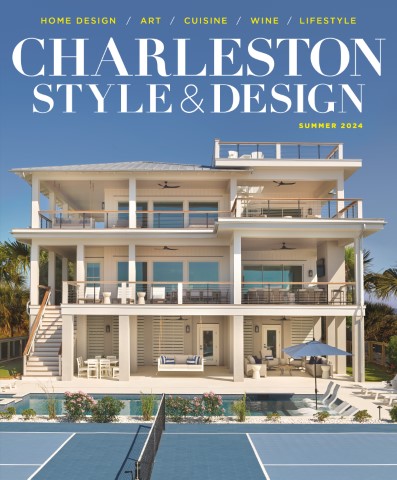
While landscapes and organic forms are the principal subjects of Madeline Dukes’ art, manifesting in abstracts, florals, landscapes and waterscapes, abstracts are closest to the heart of her vision.
“I will always lean to abstraction,” says the Charleston-based painter. “It is extremely challenging and satisfying to respond with your senses to a subject and its environment while deconstructing its space and forms.”
Dukes notes that creating work in its beginning stages is analogous to solving a puzzle.
“I break the subject matter down and then reconstruct it on canvas while simultaneously emphasizing and de-emphasizing the dynamics being played out in the painting,” she explains. “It is an absolute necessity that I keep myself open to working in both a responsive and loose manner. Needless to say, my method of creating requires tapping into my physical, spiritual and mental attributes.”
Born in Beaufort, South Carolina, Dukes spent most of her youth near the North Carolina border in Clover before attending Winthrop University. She graduated in 1996 with a degree in political science, minoring in studio art and women’s studies.

“As a very young child, I realized that I would like to be a professional artist or work in a design-oriented field,” says Dukes, who was Artist-in-Residence at the Charleston County School of the Arts in 2023. “I always felt ‘the call.’ During my 20s and early 30s, I was working full time and creating art part time, but by 2001, I was given the opportunity to begin a full-time career in visual arts.”
She and her family—husband Devin and son Devin Jr.—were lured to the Charleston area by job and cultural opportunities. And the creative environment has helped inform her work.
Dukes employs what she terms an interactive process of observation in nature to capture color, rhythm, depth, line and atmosphere.
“I take note of all sensory information, then respond accordingly on canvas,” she says. “I ask myself while painting, ‘Do I see patterns?’ ‘What does the air smell like right now?’ ‘Is the light diffused or clear?’ ‘What are the cool and warm areas?’ ‘What do you think those colors denote emotionally?’ ‘Are there repetitive shapes occurring?’ My internal dialogue goes on and on, but I have to leave it open to possibility, intuitive processes, and the ability to recognize when I’ve made a good mistake. I call it my ‘call and response time.’”

Further, she often uses juxtapositions within the work, likening it to the process of musical composition. It is no surprise that her process is intuitive, oft accompanied by music.
“Much like a musician or composer would, I place opposite elements together to create tension and interest,” she explains. “I pair bold shapes with smaller shapes. I create sections of rest against areas of action, repeat notes of color, vary patterns, etc. My intention is to marry differing elements in order to make one dynamic and cohesive piece.”
Dukes’ well-articulated artist statement defines her aesthetic purpose as one of producing transformational art that weds the three-dimensional aspects of her subject to the music it brings to the canvas.
“I want the viewer to recognize the similarities and textural components in the artwork itself, its connection to all forms of art, and the energy and rhythms found in everyday life,” she says. “I want them to explore, discover and connect the painting to their personal lives.”
Her influences are highly varied. They include the cave paintings found in Western Europe and Native American rock art, which she admires for their capacity to use art for documentation and building a narrative.

“I’ve also been influenced by the abstract expressionists, particularly Hofmann, with his ‘push-and-pull’ technique, and Willem de Kooning and Joan Mitchell for their use of line, marks and responses to both color and movement. Finally, neo-Expressionist Jean-Michel Basquiat for his flat figures and busy mark making.”
Dukes’ work has been selected for several juried group and solo shows at museums and cultural centers throughout the Carolinas, including the Etherredge Center Gallery at the University of South Carolina–Aiken, the Piccolo Spoleto Outdoor Art Exhibition, the Southeastern Wildlife Exposition (SEWE), Spartanburg Museum of Art, Lincoln County Museum, Sumter Museum of Art, McElvey Center, Mooresville Art Center, Pickens County Museum, the Jeanne Rauch Gallery at Gaston College, and a traveling show with the South Carolina State Museum.
Her work also has been showcased in Fine Art Connoisseur magazine and can be found in private and corporate collections around the United States, not least the ACE Hotel in New Orleans.
Dukes is not married to any one medium. She works chiefly in oils, acrylics, collage, oil sticks and graphite, with brushwork ranging in thickness. She will paint, layer, add, scratch and scrape around an entire canvas to achieve the desired effect: arresting areas of texture and flatness.
“I make marks to portray the energy of the subject and its surrounding atmosphere,” the artist says. “During this process, I tend to push both the paint and the imagery while relying on information from the sounds or, more often than not, the music I am playing while creating. A kind of synchronization occurs during this process. This method of painting ultimately gets me to the place I want to be. It is here that I know I am producing my most interesting work. This is the balance I enjoy, and this is how I paint.”
Her gratitude for a life in art also finds her committed to sharing that passion through teaching, offering private lessons and workshops. The reward is witnessing a student’s aha moment, when they begin to loosen up, recognize, relate and communicate what they are seeing and experiencing—but always in their individual voice, “clearly distinguishable from other artists’ work.” *
Bill Thompson is the author of As Luck Would Have It, a memoir.

